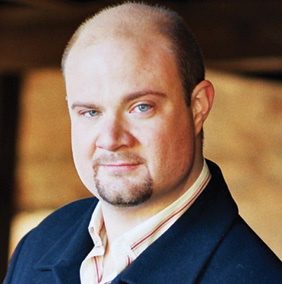Satire mixes with seriousness in New World’s French chamber program

Baritone Randall Scarlata performed music of Auric and Poulenc Sunday afternoon in the New World Symphony’s chamber concert.
Sunday afternoon’s “Satie Plus Six” program featuring the musicians of the New World Symphony offered an afternoon of light-hearted chamber music by Les Six, a group of early-twentieth century Parisian composers. Six Paris Conservatory students, including Francis Poulenc, Arthur Honegger, and Darius Milhaud, shared a passion for Erik Satie’s simple, satirical music. The concert at New World Center proved that even the lesser-known members of Les Six wrote entertaining, humorous, and occasionally profound music.
In the latter category was the Trio for violin, cello and piano by Germaine Tailleferre, the sole woman in Les Six. Completed in 1917 and revised in 1978, the Trio shows clear influences from Satie and Impressionism, with transparent textures spinning into circular seventh-chord progressions. Tailleferre’s sure scoring was underlined by breath-taking performances from violinist Amy Yi, cellist Grace An, and pianist Anna Khanina, playing with such balanced, airy lightness that the mesmerizing music left one craving more.
Also substantial, with silky ribbons of wind melodies, was Arthur Honegger’s Rhapsody from 1917, featuring supple and blended performances by flutists Melanie Lançon and Henrik Heide, clarinetist David Lemelin and pianist Khanina. An angular central march showed the satirical side of Les Six’s shared sensibility: brevity and humor, never too serious.
Guest baritone Randall Scarlata struck just the right French manner between earnestness and sarcasm in works by Georges Auric and Francis Poulenc. Auric’s Three Interludes for Baritone are paeans to ordinary objects: an ottoman, a gloxinia, and a carriage. With dark, piercing tone and agile enunciation, Scarlata expertly negotiated the rapid mood shifts between percussive recitative and the lyricism of the nuanced text, accompanied attentively by pianist Marnie Hauschildt.
Scarlata brought similar sophistication, swinging between absurdity and gravitas, to Poulenc’s tour-de-force The Masked Ball. A dark cantata about the macabre elderly of suburban 1920s Paris, The Masked Ball is most indebted to Satie, with vaudevillian percussion, rapid-fire wind trade-offs, and delicate instrumental balance. Bassoonist Evan Epifanio and trumpeter Eli Maurer’s cartoonish lines and a ripping violin passage in the “Bagatelle” from Daisuke Yamamato made for a thoroughly enjoyable concert closer. The effect was like a carnival funhouse: exciting, zany, perhaps not entirely safe.
The first half’s closer, Darius Milhaud’s Concerto for Percussion and Small Orchestra, Op. 109 from 1930, channeled a similar atmosphere, putting the poised soloist Jay Ganser through his paces from thundering timpani to triangle hits the next instant. Although the ensemble played with polished energy, placing the soloist and orchestra on opposing sides of the stage resulted in a dry lack of balance.
The only solo work was also the most recent: Louis Durey’s Three Short Pieces, Op, 115, from 1974. Oboist Henry Ward clearly conveyed the form of each, from the first’s searching melody to the last’s rapid arpeggios, with a shining upper register and subtly inflected articulations.
Less compelling, ironically, was Satie’s Three Little Stuffed Pieces from 1919. Even for Satie, the overly simplistic piano duet version of his chamber orchestra pieces based on Francois Rabelais’ Gargantua and Pantagruel left one wondering why it was chosen over so many other exquisite possibilities.
Posted in Performances
Leave a Comment
Mon Nov 5, 2012
at 1:09 pm
No Comments




